Class 11 Biology Chapter 6 Biomolecules Textbook solutions
Maharashtra state board Biology Textbook Solutions for Class 11 are very important and crusial that helps the students in understanding the hard topics and helps them in the preparation of class 11 board examination as well as verious compititive entrance examinations also. Studying the answers to the questions in the Biology textbook will check your understanding of a particular topic and helps you determine your strengths and weaknesses.
Class 11 Biology Chapter 6 Biomolecules Textbook solutions maharashtra state board are provided here with simple step-by-step detailed explanations. These solutions for Biomolecules are very popular among Class 11 students for biology chapter 6 Biomolecules Solutions come handy for quickly completing your homework and preparing for compititive exams like NEET, CET abd verious medical entrance examination also.
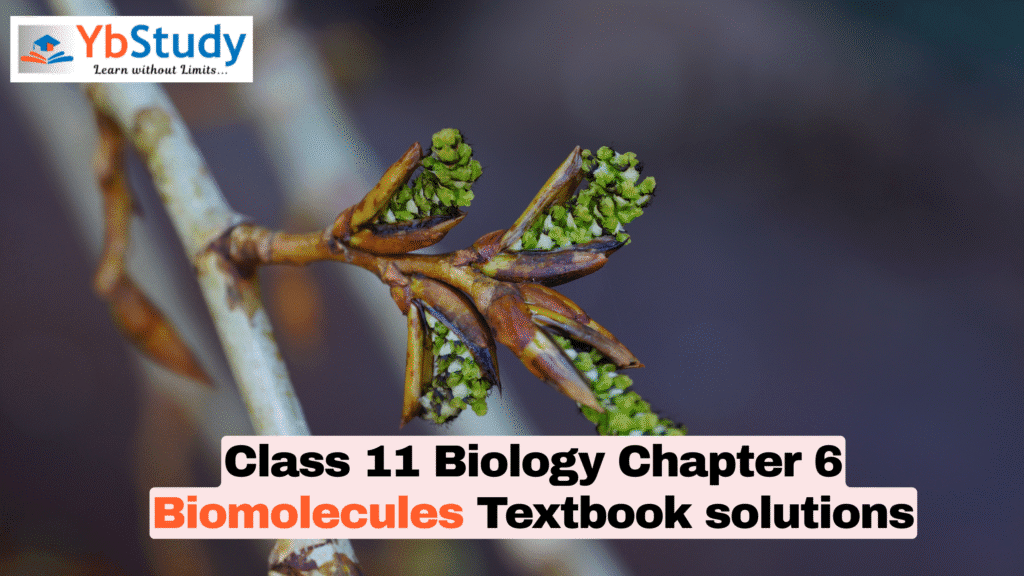
All questions and answers are taken from the class 11 Biology textbook, Bjology Textbook Solutions of Class 11 Biology Chapter 6 are provided here for you for without any charge its free for you. All Biology textbook Solutions for class 11. Solutions for class 11 Biology subject, These biology textbook solutions are prepared by experts in the field and are 100% accurate for you.
Class 11 Chapter 6 Biomolecules Solutions for Maharashtra Board
1. Choose Correct Option
A. Sugar, amino acids and nucleotides unite to their respective subunits to form——–
a. bioelements
b. micromolecules
c. macromolecules
d. all of these
B. Glycosidic bond is found in —————.
a. Disaccharide
b. Nucleosides
c. Polysaccharide
d. all of theses
C. Amino acids in a polypeptide are joinedby —————bond.
a. Disulphide
b. glycosidic
c. hydrogen bond
d. none of these
D. Lipids associated with cell membrane are ————.
a. Spingomyelin
b. Isoprenoids
c. Phospolipids
d. Cholesterol
E. Linoleic, Linolenic and ——————–acids are referred as essential fatty acids since they cannot be synthesized by the body and hence must be included in daily diet.
a. Arachidonic
b. Oleic
c. Steric
d. Palmitic
F. Haemoglobin is a type of ————– protein, which plays indispensible part in respiration.
a. simple
b. derived
c. conjugated
d. complex
G. When inorganic ions or metallo-organic molecules bind to apoenzyme, they together form——
a. isoenzyme
b. holoenzyme
c. denatured enzyme
d. none of these
H. In enzyme kinetics, Km= Vmax/2. If Kmvalue is lower, it indicates —————-
a. Enzyme has less affinity for substrate
b. Enzyme has higher affinity towards substrate
c. There will be no product formation
d. All active sites of enzyme are saturate
2. Solve the Following Questions
A. Observe the following figure and name the type of bond shown by arrow in the structure.
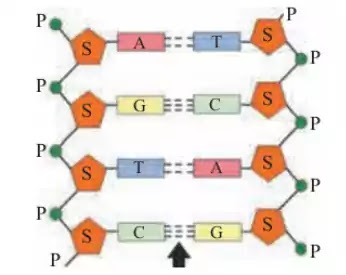
Answer: Hydrogen Bond
3. Answer the Following Questions
A. What are building blocks of life?
Answer: Cell is the basic structural and fundamental unit of life. It is known as the building block of life because all the organisms are made up of cells. From unicellular to multicellular, the basic body structure and plan start with cell.
B. Explain the peptide bond.
Answer: A peptide bond is a chemical bond formed between two molecules when the carboxyl group of one molecule reacts with the amino group of the other molecule, releasing a molecule of water (H2O). This is a dehydration synthesis reaction (also known as a condensation reaction), and usually occurs between amino acids.
C. How many types of polysaccharides you know?
Answer: Sometimes known as glycans, there are three common and principal types of polysaccharide, cellulose, starch and glycogen, all made by joining together molecules of glucose in different ways.
D. Enlist the significance of carbohydrates.
Answer: It supplies energy for metabolism.Glucose is the main substrate for ATPsynthesis. Lactose, a disaccharide is presentin milk provides energy to lactating babies. Polysaccharide serves as structural componentof cell membrane, cell wall and reserved food as starch and glycogen.
E. What is reducing sugar?
Answer: Reducing sugar. A sugar that serves as a reducing agent due to its free aldehyde or ketone functional groups in its molecular structure. Examples are glucose, fructose, glyceraldehydes, lactose, arabinose and maltose, except for sucrose.
F. What is the basic difference between saturated and unsaturated fatty acid?
Answer: Saturated fatty acids lack double bonds between the individual carbon atoms, while in unsaturated fatty acids there is at least one double bond in the fatty acid chain. Saturated fats tend to be solid at room temperature and from animal sources, while unsaturated fats are usually liquid and from plant sources.
G. Enlist the examples of simple protein and add their significance.
Answer: Some of the simple proteins are Gluteins, Albumins, globulins, histones, protamines et cetera. Proteins are very important for the body as it is the structural and functional unit of body. The simple proteins can also sever many important functions in the body. Such as albumin helps the body in maintaining the colloid osmotic pressure of the body. It neutralizes the toxins of the body and helps in the transport of the therapeutic agents. Globulins in the body helps in preventing the enzymes that causes clumps in the body.
H. Explain the secondary structure of protein with examples.
Answer: Secondary structure elements typically spontaneously form as an intermediate before the protein folds into its three dimensional tertiary structure. Secondary structure is formally defined by the pattern of hydrogen bonds between the amino hydrogen and carboxyl oxygen atoms in the peptide backbone.
I. Explain the induced fit model for mode of enzyme action.
Answer: Koshland (1959) proposed the induced fit theory, which states that approach of a substrate induces a conformational change in the enzyme. It is the more accepted model to understand mode of action of enzyme. Unlike the lock-and-key model, the induced fit model
shows that enzymes are rather flexible structures in which the active site continually reshapes by its interactions with the substrate until the time
the substrate is completely bound to it (it is also the point at which the final form and shape of the enzyme is determined).
J. What is RNA? Enlist types of RNA.
Answer: RNA is a single-stranded nucleic acid that is composed of three main elements: a nitrogenous base, a five-carbon sugar and a phosphate group. Messenger RNA (mRNA), transfer RNA (tRNA) and ribosomal RNA (rRNA) are the three major types of RNA.
K. Describe the concept of metabolic pool.
Answer: Metabolite pool is a collective term for all of the substances involved in the metabolic process in a biological system. Metabolic pools are within cells (or organelles such as chloroplasts) and refer to the reservoir of molecules upon which enzymes can operate.
L. How do secondary metabolites useful for mankind?
Answer: These secondary metabolites are often used by the humans. They are used as a drug that provide protection against the pathogens and improves the immune system. Secondary metabolites like flavonoids are directly eaten up by the plants that provide nutrients source to humans.
4. Solve the Following Questions
A. Complete the following chart. Protein Physiological role.
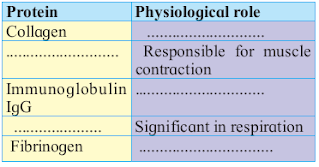
Answer :
Collagen : Provide strength and important component of extracellular matrix.
Actin and myosin : Responsible for muscle contraction.
Immunoglobulin: Provides immunity and fight against the antigen.
B. Answer the questions with reference to the following figure.
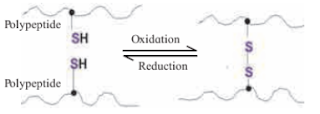
i. Name the type of bond formed between two polypeptides.
Answer : Disulfide bond
ii. Which amino acid is involved in the formation of such bond?
Answer :cysteine
iii. Amongst I, II, III and IV structural level of protein, which level of structure includes such bond?
Answer : tertiary structure
C. Match the following items given in
column I and II.
i. RNA. a. Induced fit model
ii. Yam plant. b.Flax seeds
iii. Koshland. c. Hydrolase
iv. Omega-3-fatty acid d. Uracil
v. Sucrase. e. Anti-fertility pills
Answer :
RNA = Uracil
Antifertility pills = flax seed
Kosland = induce fit model(enzymes)
Yam plant = Omega-3 fatty acid
Sucrase = hydrolase
5. Long Answer Questions
A. What are biomolecules? Explain the building blocks of life.
Answer: Biomolecules are the basic components which living organisms are made up of. Carbon forms the basic unit of most of the biomolecules. The basic biomolecules with which organisms are made of are: The Four Macromolecules: All life is composed mainly of the four macromolecule building blocks: carbohydrates, lipids, proteins, and nucleic acids. The interactions of different polymers of these basic molecule types make up the majority of life’s structure and function.
B. Explain the classes of carbohydrates with examples.
Answer: The basis of the number of forming units, three major classes of carbohydrates can be defined: monosaccharides, oligosaccharides and polysaccharides.
Monosaccharides or simply sugars are formed by only one polyhydroxy aldehydeidic or ketonic unit. The most abundant monosaccharide is D-glucose, also called dextrose
2. Disaccharides: Monosaccharides are rare in nature. Most sugars found in nature are disaccharides. Disaccharide is formed when two monosaccharide react by condensation reaction.
3. Polysaccharides:
Monosaccharides can undergo a series of condensation reactions, adding one unit after the other to the chain till a very large molecule (polysaccharide) is formed. This is called polymerization. Polysaccharides are broken down by hydrolysis into monosaccharides. The properties of a polysaccharide molecule depend on its length, branching, folding and coiling.
C. Describe the types of lipids and mention their biological significance.
Answer: Lipids perform three primary biological functions within the body: they serve as structural components of cell membranes, function as energy storehouses, and function as important signaling molecules. The three main types of lipids are triacylglycerols (also called triglycerides), phospholipids, and sterols.
Significance of lipids : Lipids are essential for all life on Earth. They play many important roles in maintaining the health of an organism. Arguably the most important function lipids perform is as the building blocks of cellular membranes. Other functions include energy storage, insulation, cellular communication and protection.
D. Explain the chemical nature, structure and role of phospholipids in biological membrane.
Answer: Phospholipids consist of a hydrophilic (or ‘water loving’) head and a hydrophobic (or ‘water fearing’) tail. Phospholipids like to line up and arrange themselves into two parallel layers, called a phospholipid bilayer. This layer makes up your cell membranes and is critical to a cell’s ability to function.
E. Describe classes of proteins with their importance.
Answer : The classes of protein: Proteins can be divided into three classes according to their structure – they are:
Globular proteins – These proteins are small in structure with a “more or less spherical” shape. These proteins are often found in blood like albumin, globulin, etc.
Fibrous proteins – These proteins are fibrous, with some resistance and carrying capacity. These proteins are found in cells with bearing effects. Examples of these proteins are fibrins, collagen, elastin, etc.
Membranous proteins – These proteins are flat Membranous in appearance. Examples include, they are often found in cell membranes and are involved in transport of materials “in and out” of the cell.
F. What are enzymes? How are they classified? Mention example of each class.
Answer: Enzymes are the biocatalyst which enhance the rate of reaction by decresing activation energy According to the type of reactions that the enzymes catalyze, enzymes are classified into seven categories, which are oxidoreductases, transferases, hydrolases, lyases, isomerases, ligases, and translocases. Oxidoreductases, transferases and hydrolases are the most abundant forms of enzymes. Individual enzyme classes are further classified systematically based on the chemical name of the substrate and its reaction mechanism.
1. Oxidoreductases: Catalyze redox reaction and can be categorized into oxidase and reductase.
2. Transferases: Catalyze the transfer or exchange of certain groups among some substrates
3. Hydrolases: Accelerate the hydrolysis of substrates
4. Lyases: Promote the removal of a group from the substrate to leave a double bond reaction or catalyze its reverse reaction
5. Isomerases: Facilitate the conversion of isoisomers, geometric isomers or optical isomers.
6. Ligases: Catalyze the synthesis of two molecular substrates into one molecular compound with the release energy
G. Explain the properties of enzyme? Describe the models for enzyme actions.
Answer:
1. Proteinaceous Nature : All enzymes are basically made up of protein.
2. Three-Dimensional conformation : All enzymes have specific 3-dimensional conformation. They have one or more active sites to which substrate (reactant) combines.
3. Specificity of action : The ability of an enzyme to catalyse one specific reaction and essentially no other is perhaps its most significant property.
4. Reversibility of action : Enzymes are very sensitive to temperature and pH. Each enzyme exhibits its highest activity at a specific pH, called optimum pH. Any increase or decrease in pH causes decline in enzyme activity e.g. enzyme pepsin (secreted in stomach) shows highest activity at an optimum pH of 2 (acidic). Trypsin (in duodenum) is most active at an optimum pH of 9.5 (alkaline). Both these enzymes viz. pepsin and trypsin are protein digesting enzymes.
Mode of action :
Lock and Key model:

The specific action of an enzyme with a single substrate can be explained using a Lock and Key analogy first postulated in 1894 by Emil Fischer. In this analogy, the lock is the enzyme and the key is the substrate. Only the correctly sized key (substrate) fits into the key hole (active site) of the lock (enzyme).
Induced Fit model (Flexible Model):
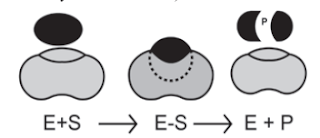
Koshland (1959) proposed the induced fit theory, which states that approach of a substrate induces a conformational change in the enzyme. It is the more accepted model to understand mode of action of enzyme. Unlike the lock-and-key model, the induced fit model shows that enzymes are rather flexible structures in which the active site continually reshapes by its interactions with the substrate until the time the substrate is completely bound to it (it is also the point at which the final form and shape of the enzyme is determined).
H. Describe the factors affecting enzyme action.
Answer :
1. Concentration of Substrate: Increase in the substrate concentration gradually increases the velocity of enzyme activity within the limited range of substrate levels. A rectangular hyperbola is obtained when velocity is plotted against the substrate concentration. Three distinct phases (A, B and C) of the reaction are observed in the graph.
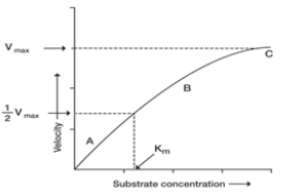
Where V = Measured velocity, Vmax = Maximum
velocity, S = Substrate concentration, Km =
Michaelis-Menten constant.
2. Enzyme Concentration: The rate of an enzymatic reaction is directly proportional to the concentration of the substrate. The rate of reaction is also directly proportional to the square root of the concentration of enzymes. It means that the rate of reaction also increases with the increasing concentration of enzyme. And the rate of reaction can also decreased by decreasing the concentration of enzyme.
3. Temperature: The enzymatic reaction occurs best at or around 37°C which is the average normal body temperature in homeotherms. The rate chemical reaction is increased by a rise in temperature but this is true only over a limited range of temperature.
4. Effect of pH: Similar to temperature, there is also pH at which an enzyme will catalyze the reaction at the maximum rate. Every enzyme has different optimum pH value. The enzyme cannot perform its function beyond the range of its pH value.
5. Other Substances: The enzymes action is also increased or decreased in the presence of some other substances such as co-enzymes, activators and inhibitors. Most of the enzymes are combination of a co-enzyme and an apo-enzyme. Activators are the inorganic substances which increase the enzyme activity. Inhibitor is the substance which reduces the enzyme activity.
